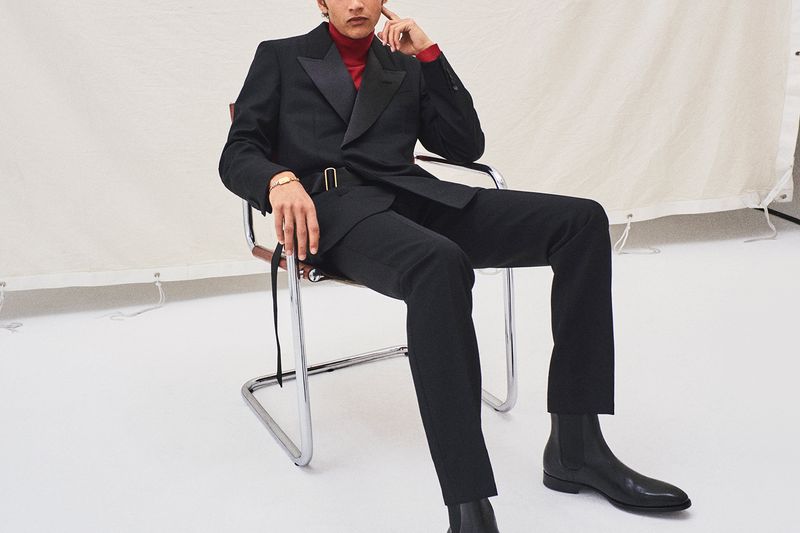THE JOURNAL
Why Dunhill’s New-Wave Collection Is A Masterclass In Timely Yet Timeless Style

It is often said that you can’t win an argument by raising your voice. Though few, it seems, have heeded such advice of late. In a style space at times buzzing with bold logos, blaring prints and downright outlandish silhouettes, it’s reassuring that, in spite of the cacophony, Dunhill – that paragon of British style – is not a brand that feels the need to shout.
Founded in 1893 by Mr Alfred Dunhill – who saw the potential in a growing automobile market – it chiefly provided “everything for the car except the motor” until the company found its niche in the menswear market during the 1970s as a purveyor of traditional tailoring and classic clothing. With Burberry alum Mr Mark Weston at the helm since 2017, the label has adopted a distinct agenda, one that respects the past and the present, subverting those ingrained codes of menswear – the stuffy, staid remnants of times gone by – and repackaging them into something new but not entirely unexpected.

The notion that there’s one, static, unyielding definition of what constitutes “classic clothing” isn’t something that Dunhill subscribes to, anyway. It is a fact of doing business these days that when labels are trying to corner a specific market, they often imagine their customer as a singular, predictable character – as if the modern man can be reduced to an archetype unmovable in his opinions and unevolved in his sartorial habits. Who, then, is the Dunhill man? It’s refreshing to hear, as Mr Weston explains in the notes for the new collection, that to his mind “Dunhill is not one thing, it’s many”.
Recognising that opposites attract – and that our wardrobes, much like ourselves, contain multitudes – is not a novel deduction by any means. But executing it harmoniously, without resorting to something approaching a jumble-sale aesthetic or disregarding the principles of luxury make and manufacture, is altogether trickier than it looks.
And herein lies the genius of Dunhill’s quietly confident formula, perhaps best illustrated by its latest outing. The AW20 collection is inspired by ostensibly flamboyant source material: Mr Homer Sykes’ photographs of the Blitz Kids, that style-conscious group of students and celebrities (Messrs Steve Strange, Gary Kemp and Rusty Egan among them) known to frequent London’s Covent Garden clubs in the late 1970s and early 1980s. It was here, one Tuesday night on the town, that the New Romantics movement was born. Some four decades on, Dunhill salutes this meeting of what it calls “the old guard and the avant-garde”.

Finding common ground between establishment types and the revolutionaries is all very well in theory, but what, you may be enquiring, does this mean for the clothes themselves? Well, we’ll get right to it. Subtlety might be the brand’s strong suit, but that isn’t to suggest that the end result isn’t seriously standout. You can, it turns out, craft exquisite Italian-made tailoring replete with bondage-inspired straps without the suit in question being compared to a Halloween costume.
In fact, like the exaggerated zip-up point collar shirt or the virgin wool drawstring track pants also seen in this collection, it’s still very much something that you could don to a business meeting or client dinner without finding yourself on the receiving end of a few elevated eyebrows. How often these days are you able to honestly say that about a runway collection? It is, as we’ve already covered, really rather refreshing.

Another way Mr Weston has distinguished himself is by reworking and reimagining Dunhill’s established codes and signatures. Outerwear, historically something the brand does awfully well, is unsurprisingly a real MVP this season. Hence, the oversized navy Melton wool overcoat (a majestically sweeping example if ever there was) and the buttery-soft calfskin Duke leather jacket, a nod to the label’s distinguished motoring heritage. These, it will not have escaped your notice, are the sorts of pieces that will anchor a wardrobe for years to come.
And it doesn’t stop at the clothes. The shoes and accessories have not been spared this revivalist treatment, either. A flawless exemplar, the Lock bag (so-named for its distinctive brass closure) takes an archival attaché case from the 1960s as its starting point and is transformed into what is perhaps the finest iteration of the smaller-than-average bag trend we’ve seen to date. And no, we promise that’s not just clever lighting or a post-production trick – the leather really is every bit that silken in the flesh.

Also contending for collection headliners are the sneakers. One style, the Axis, is a technical update to a retro runner from the 1970s. The other, the Italian-crafted Court Elite references vintage 1980s tennis shoes. While they might spiritually belong to different eras, both are exactly the sort of thing you can wear to loaf around town on the weekend, yet manage to look right at home with smarter trousers and tailoring if a more formal occasion calls for it.
Which brings us back to what Dunhill (and MR PORTER, really) is all about. At a time when the fashion industry grows louder and louder, while the world itself gets more uncertain, is there any need for yet more clothes that trumpet their presence? Dunhill, instead, lets the clothes (and those who wear them) speak for themselves.